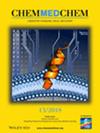基于底物的双位点抑制剂抑制 SARS-CoV-2 nsp16 的结构基础
IF 3.6
4区 医学
Q2 CHEMISTRY, MEDICINAL
引用次数: 0
摘要
包括 SARS-CoV-2 在内的冠状病毒拥有一种 mRNA 5' 带帽装置,能够模仿真核生物的天然带帽特征。两种依赖于 SAM 的甲基化酶在这一过程中发挥了重要作用:nsp14 对鸟苷帽的 N7 进行甲基化,nsp16-nsp10 对病毒 mRNA 随后核苷酸的 2'-O- 进行甲基化。nsp16-nsp10 进行的 2'-O- 甲基化是病毒 RNA 摆脱先天免疫的关键。抑制这种酶的活性被认为是对抗冠状病毒的一种方法。在这项研究中,我们利用 X 射线晶体学分析了 SAM 类似物与 nsp16-nsp10 活性位点的结合。我们获得了 nsp16-nsp10 与 SAM 衍生抑制剂复合物的十一种三维晶体结构,展示了分子中蛋氨酸取代部分的不同构象,并证实了同时靶向 SAM 和 RNA 两个位点具有更高的抑制潜力。本文章由计算机程序翻译,如有差异,请以英文原文为准。
Structural basis for inhibition of the SARS‐CoV‐2 nsp16 by substrate‐based dual site inhibitors
Coronaviruses, including SARS‐CoV‐2, possess an mRNA 5' capping apparatus capable of mimicking the natural eukaryotic capping signature. Two SAM‐dependent methylating enzymes play important roles in this process: nsp14 methylates the N7 of the guanosine cap, and nsp16‐nsp10 methylates the 2'‐O‐ of subsequent nucleotides of viral mRNA. The 2'‐O‐methylation performed by nsp16‐nsp10 is crucial for the escape of the viral RNA from innate immunity. Inhibition of this enzymatic activity has been proposed as a way to combat coronaviruses. In this study, we employed X‐ray crystallography to analyze the binding of the SAM analogues to the active site of nsp16‐nsp10. We obtained eleven 3D crystal structures of the nsp16‐nsp10 complexes with SAM‐derived inhibitors, demonstrated different conformations of the methionine substituting part of the molecules, and confirmed that simultaneous dual‐site targeting of both SAM and RNA sites correlates with higher inhibitory potential.
求助全文
通过发布文献求助,成功后即可免费获取论文全文。
去求助
来源期刊

ChemMedChem
医学-药学
CiteScore
6.70
自引率
2.90%
发文量
280
审稿时长
1 months
期刊介绍:
Quality research. Outstanding publications. With an impact factor of 3.124 (2019), ChemMedChem is a top journal for research at the interface of chemistry, biology and medicine. It is published on behalf of Chemistry Europe, an association of 16 European chemical societies.
ChemMedChem publishes primary as well as critical secondary and tertiary information from authors across and for the world. Its mission is to integrate the wide and flourishing field of medicinal and pharmaceutical sciences, ranging from drug design and discovery to drug development and delivery, from molecular modeling to combinatorial chemistry, from target validation to lead generation and ADMET studies. ChemMedChem typically covers topics on small molecules, therapeutic macromolecules, peptides, peptidomimetics, and aptamers, protein-drug conjugates, nucleic acid therapies, and beginning 2017, nanomedicine, particularly 1) targeted nanodelivery, 2) theranostic nanoparticles, and 3) nanodrugs.
Contents
ChemMedChem publishes an attractive mixture of:
Full Papers and Communications
Reviews and Minireviews
Patent Reviews
Highlights and Concepts
Book and Multimedia Reviews.
 求助内容:
求助内容: 应助结果提醒方式:
应助结果提醒方式:


